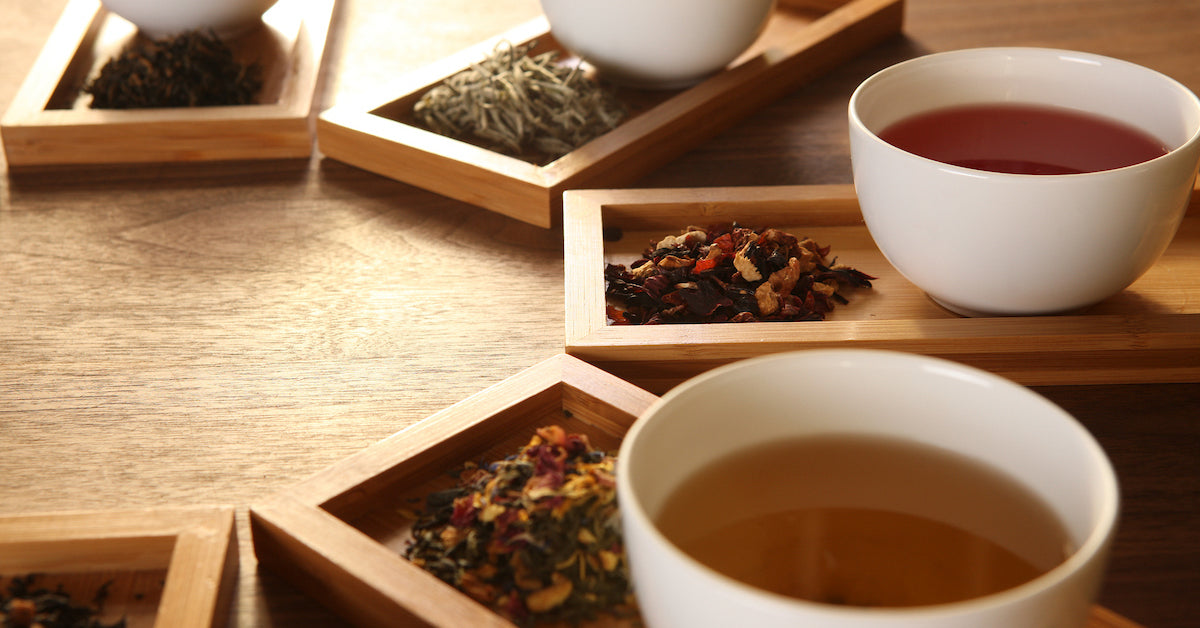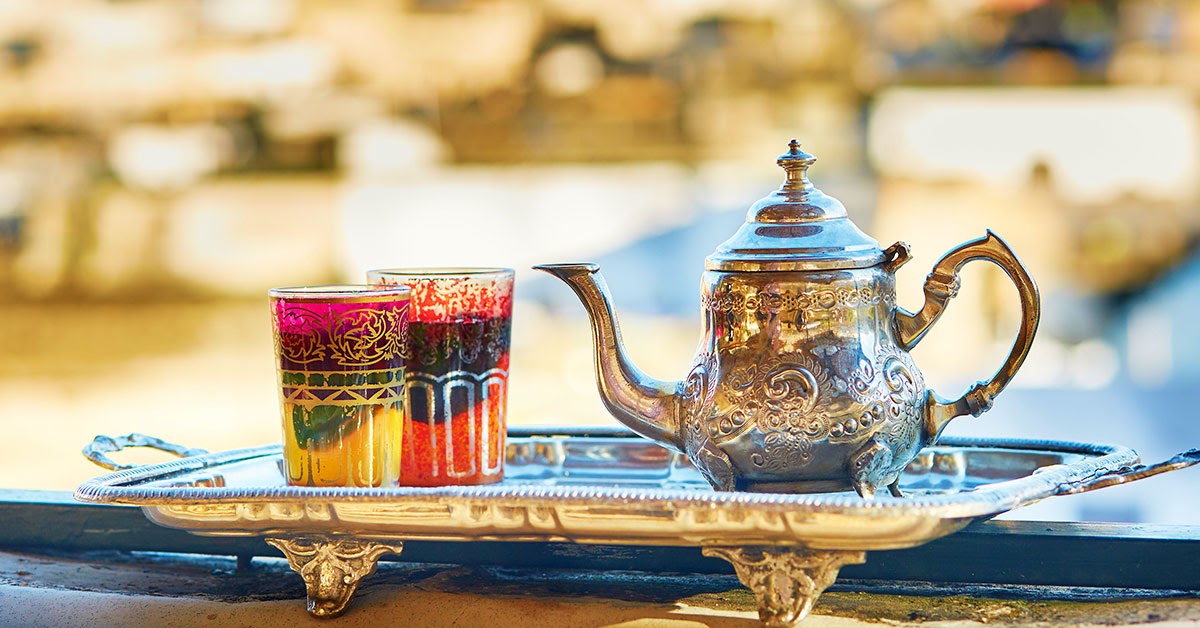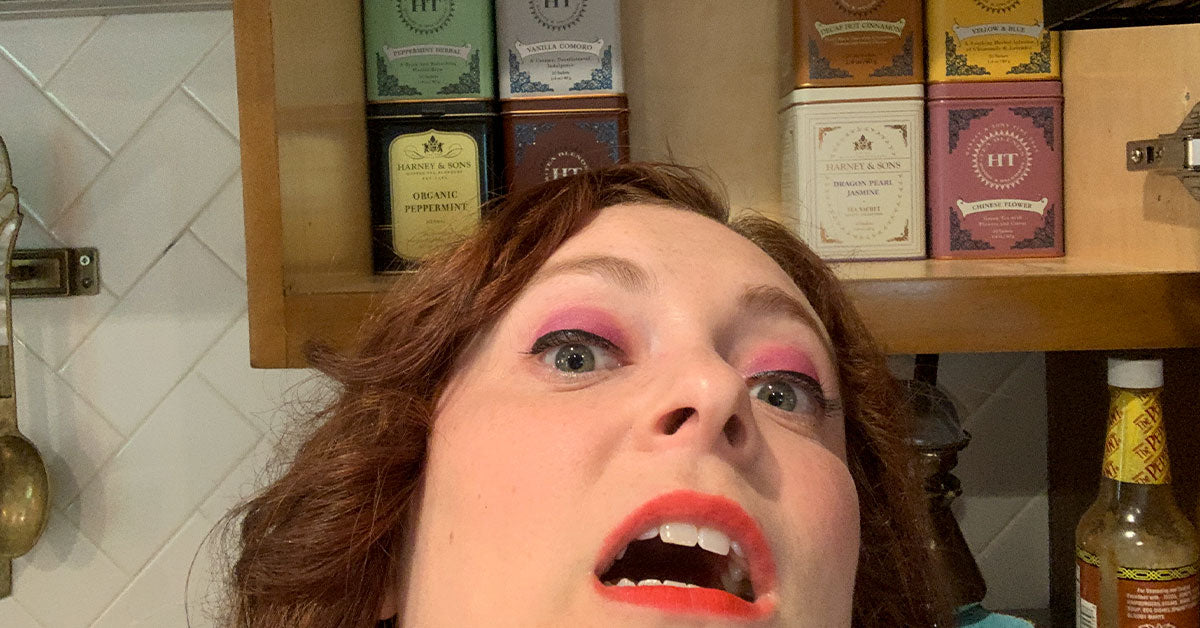Before you quit reading because you think this is going to be some snooty treatise on what kind of china you should use and what kind of expensive French-imported macarons you should serve and what kind of fancy hat you should wear, know that we don’t really think there’s a wrong or right way to drink tea. If drinking tea out of a tin cup in your favorite sweats with that stain on the knee, sitting in a camp chair by a fire is what fills your soul, we say do it!
However...if you want to take a deep dive into the truly complex properties of tea, reveal all its flavors and nuances, you might consider trying these techniques. Because getting the full experience of what tea has to offer involves engaging in some rituals and a very specific way of tasting the tea. We warn you: if you have a fear of making odd sounds in front of others, you should do this alone at home. But if you don’t give a teabag about what others think, drink your tea this way no matter where you are.

First Things First
To really get the full meal deal when tasting tea, you need to ditch the teabags and use a teapot and loose leaves. You should also think about using a thermometer to check the water temperature before you brew as different teas do best in different temps. Use filtered water, not tap water -- this is a pretty basic hard-and-fast rule of getting the best cuppa. Finally, once the tea is poured off, jam your nose into the teapot to see how many aromas you can smell. As you’ll soon find out, smell is a huge factor in tasting tea.
While there are several steps ahead of the actual tasting -- like examining the dry leaves, brewing, looking at and smelling the tea, all of which you can learn more about in my dad’’s book The Harney & Sons Guide to Tea -- we’re going to focus on the actual tasting process.

The Proper Way to Taste Tea Is Slurping
Professional tea tasters don’t just drink their tea; they slurp it the way one might slurp hot soup. The point is not to cool the tea, but to aerate it to allow more of the aromas to drift up to the olfactory region (aka your nose) to smell the tea as well as to taste it. If you find the tea is too hot, wait a few minutes more. The tea should be warm but not scalding.
Here’s how you do it: pull sharply on the tea, inhaling quickly through your mouth to run it between your lips and teeth. Don’t be afraid to slurp really loudly. Once you have the aerated tea in your mouth, swish it around with your tongue and cheeks to give every last taste bud a chance to try it out. By being able to both taste and smell the tea, we access our limitless library of knowledge of things we’ve been exposed to as a reference point.
A couple of years back, I did a tea-tasting video for Epicurious that you can watch here. I employed this method of tasting tea, so watching might give you a better idea of the technique -- and how silly it can sound!
Some things to look for:
Body. Assess the weight of the tea. Does it feel thin like water or thick like cream? “Body” refers to a tea’s heft or weight, how much substance or texture it has. White teas and Chinese green teas are very light, feeling almost like water. Thicker Japanese green teas often feel brothy, a little like chicken soup with their greater heft. Some oolongs are actually called “creamy” for the way they coat your mouth like heavy cream. Black teas have a different kind of heft: their body is often described as brisk or astringent for the way they dry up the mouth.
A tea’s body is also among the best indicators of brew strength. While a poorly brewed tea will still release plenty of aromas, its body will suffer. Does the tea feel thin or wan? Even the lightest teas should have a little texture; a thin tea probably needs more time to brew and may also need a pinch more dry leaves. Alternatively, does it taste bitter and make your mouth pucker? Then the tea may be over-brewed.
Flavors. Once you have established the tea’s aromas and body, at long last you can begin to tease out its flavors. Ask yourself what else the tea tastes like: spinach? Mangoes? Keep tasting. Like great wines, the teas will change their flavors the longer you hold them in your mouth. The flavors will also evolve as the tea cools and, in some instances, as with puerhs and oolongs, as you rebrew the leaves. After you’ve swallowed the tea, see how long you can continue to taste it. The final mark of a great tea is how long its flavor endures in the mouth after you’ve swallowed. This endurance is called a tea’s “finish,” or “aftertaste,” and for some teas it can last as long as 10 to 15 minutes.

And that’s all there is to it! Except for one more Harney rule: have fun! My dad learned an extremely valuable lesson from the renowned German tea broker Bernd Wulf, who taught him this method of tasting teas. He told my dad to notice his mood as he slurped and sipped and then offered this advice, “Only buy teas that make you smile.” As you embark on your tea tasting adventure, sussing out which tea flavors you like and which ones you’re meh about, remember this: Only drink teas that make you smile.
Happy slurping!!
















10 comments
Pamela Loeb
This article made me start reading “because I should” and because I love African Autumn. It was so interesting that I read it with great enjoyment and a resolve to try the slurping method. Thank you so much!!!
This article made me start reading “because I should” and because I love African Autumn. It was so interesting that I read it with great enjoyment and a resolve to try the slurping method. Thank you so much!!!
Patricia K. Johnson
Very interesting! Enjoyed listening how to “sip” your tea. Will check that out with my morning tea.
Very interesting! Enjoyed listening how to “sip” your tea. Will check that out with my morning tea.
Jennifer
I’ve never once left a review on an article. This article was soooo good and informative. Thank you sincerely for your knowledge and the last nugget on the end. Great work!
I’ve never once left a review on an article. This article was soooo good and informative. Thank you sincerely for your knowledge and the last nugget on the end. Great work!
Norma Thiel
I have been drinking kukicha tea for 45 years (in tea bags!). I would like to try loose tea, as I have heard (from a Japanese acquaintance) there is a significant difference in taste. Soooo, I am a “loose tea” virgin. How much loose tea do I use? What kind of device do I use to brew the loose tea?
I have been drinking kukicha tea for 45 years (in tea bags!). I would like to try loose tea, as I have heard (from a Japanese acquaintance) there is a significant difference in taste. Soooo, I am a “loose tea” virgin. How much loose tea do I use? What kind of device do I use to brew the loose tea?
Suzanne Pool
Jana said John Harney showed her how to remove most of the caffeine from tea, but didn’t explain further.
I’ve heard that you pour off the first infusion, discard and the next infusion will be mostly decaffeinated.
Is that right?
Jana said John Harney showed her how to remove most of the caffeine from tea, but didn’t explain further.
I’ve heard that you pour off the first infusion, discard and the next infusion will be mostly decaffeinated.
Is that right?
Lisa
Informative and helpful – I will use this method with my morning tea tomorrow! Thank you!
Informative and helpful – I will use this method with my morning tea tomorrow! Thank you!
Kathy Vincent
I enjoyed the article and video. I learned a lot and appreciate all you do to make my tea it’s very best experience!
I enjoyed the article and video. I learned a lot and appreciate all you do to make my tea it’s very best experience!
Jana
Excellent article – one of the best I’ve read on the characteristics of tea. One question: I’ve always heard that only coffee was ’brewed" and that tea was “steeped.” So perhaps over-steeping rather than over-brewing can produce bitterness.
I had the honor of meeting and dining with John Harney as part of a tea train tour I took in the 1990s. It was from him that I first learned how to remove most of the caffeine from tea.
Thank you for this fine article and video.
Excellent article – one of the best I’ve read on the characteristics of tea. One question: I’ve always heard that only coffee was ’brewed" and that tea was “steeped.” So perhaps over-steeping rather than over-brewing can produce bitterness.
I had the honor of meeting and dining with John Harney as part of a tea train tour I took in the 1990s. It was from him that I first learned how to remove most of the caffeine from tea.
Thank you for this fine article and video.
adam krolnik
Being a home brewer, I treat my source water with various salts or minerals to the particular style I am making. Do you have any recommendations for salt or mineral levels for particular teas ? I’m enjoying your Paris tea as I type.
Thx
Being a home brewer, I treat my source water with various salts or minerals to the particular style I am making. Do you have any recommendations for salt or mineral levels for particular teas ? I’m enjoying your Paris tea as I type.
Thx
Mary
I enjoyed learning how to really taste tea. You expanded my knowledge and love of tea.
I enjoyed learning how to really taste tea. You expanded my knowledge and love of tea.